Deck 3: The Enhanced E-R Model and Business Rules
Question
Question
Question
Question
Question
Question
Question
Question
Question
Question
Question
Question
Question
Question
Question
Question
Question
Question
Question
Question
Question
Question
Question
Question
Question
Question
Question
Question
Question
Question
Question
Question
Question
Question
Question
Question
Question
Question
Question
Question
Question
Question
Question
Question
Question
Question
Question
Question
Question
Question
Question
Question
Question
Question
Question
Question
Question
Question
Question
Question
Question
Question
Question
Question
Question
Question
Question
Question
Question
Question
Question
Question
Question
Question

Unlock Deck
Sign up to unlock the cards in this deck!
Unlock Deck
Unlock Deck
1/74
Play
Full screen (f)
Deck 3: The Enhanced E-R Model and Business Rules
1
In the figure below,which of the following are subtypes of patient?
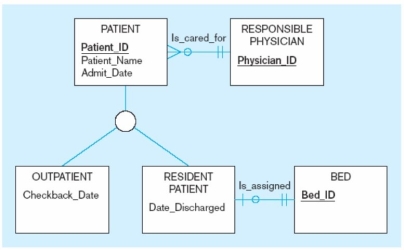
A) Outpatient
B) Physician
C) Bed
D) All of the above

A) Outpatient
B) Physician
C) Bed
D) All of the above
A
2
In the figure below,a student:
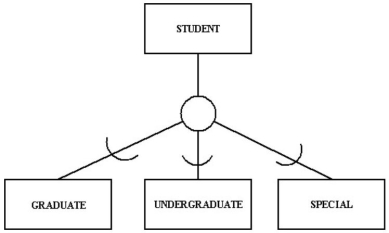
A) must be a graduate student, an undergraduate, a special student or some other type of student.
B) must be a graduate student or an undergraduate student.
C) must be at least a special student.
D) none of the above.

A) must be a graduate student, an undergraduate, a special student or some other type of student.
B) must be a graduate student or an undergraduate student.
C) must be at least a special student.
D) none of the above.
A
3
In the figure below,the patient must be either an outpatient or a resident patient.This is an example of the ________ rule.
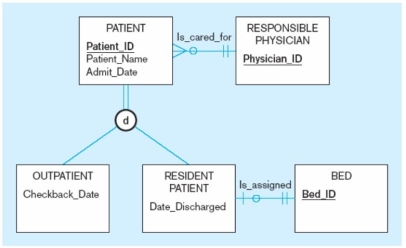
A) disjoint
B) specialization
C) generalization
D) overlap

A) disjoint
B) specialization
C) generalization
D) overlap
A
4
Which of the following is a generic entity type that has a relationship with one or more subtypes?
A) Megatype
B) Supertype
C) Subgroup
D) Class
A) Megatype
B) Supertype
C) Subgroup
D) Class

Unlock Deck
Unlock for access to all 74 flashcards in this deck.
Unlock Deck
k this deck
5
The subtype discriminator in the figure below is:
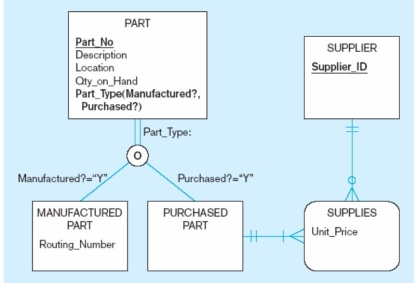
A) Part_Type.
B) Part_No.
C) Manufactured Part.
D) Location.

A) Part_Type.
B) Part_No.
C) Manufactured Part.
D) Location.

Unlock Deck
Unlock for access to all 74 flashcards in this deck.
Unlock Deck
k this deck
6
The ________ rule specifies that each entity instance of the supertype must be a member of some subtype in the relationship.
A) semi-specialization
B) total specialization
C) partial specialization
D) total convergence
A) semi-specialization
B) total specialization
C) partial specialization
D) total convergence

Unlock Deck
Unlock for access to all 74 flashcards in this deck.
Unlock Deck
k this deck
7
The process of defining a more general entity type from a set of more specialized entity types is called:
A) generalization
B) specialization
C) normalization
D) none of the above
A) generalization
B) specialization
C) normalization
D) none of the above

Unlock Deck
Unlock for access to all 74 flashcards in this deck.
Unlock Deck
k this deck
8
The subtype discriminator is a composite attribute when there is a(n):
A) overlap rule.
B) disjoint rule.
C) partial specialization.
D) full specialization.
A) overlap rule.
B) disjoint rule.
C) partial specialization.
D) full specialization.

Unlock Deck
Unlock for access to all 74 flashcards in this deck.
Unlock Deck
k this deck
9
The ________ rule states that an entity instance can simultaneously be a member of two (or more)subtypes.
A) disjoint
B) overlap
C) partial specialization
D) total specialization
A) disjoint
B) overlap
C) partial specialization
D) total specialization

Unlock Deck
Unlock for access to all 74 flashcards in this deck.
Unlock Deck
k this deck
10
The ________ rule specifies that an entity can be a member of only one subtype at a time.
A) exclusion
B) disjoint
C) removal
D) inclusion
A) exclusion
B) disjoint
C) removal
D) inclusion

Unlock Deck
Unlock for access to all 74 flashcards in this deck.
Unlock Deck
k this deck
11
In the figure below,to which of the following entities are the entities "CAR" and "TRUCK" generalized?
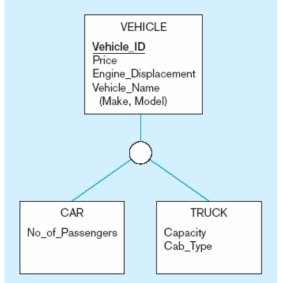
A) Make
B) Vehicle
C) Model
D) Price

A) Make
B) Vehicle
C) Model
D) Price

Unlock Deck
Unlock for access to all 74 flashcards in this deck.
Unlock Deck
k this deck
12
A ________ addresses whether an instance of a supertype may simultaneously be a member of two or more subtypes.
A) disjointedness constraint
B) disjoint rule
C) partial specialization
D) total specialization
A) disjointedness constraint
B) disjoint rule
C) partial specialization
D) total specialization

Unlock Deck
Unlock for access to all 74 flashcards in this deck.
Unlock Deck
k this deck
13
An attribute of the supertype that determines the target subtype(s)is called the:
A) determinant.
B) subtype decision.
C) disjoint indicator.
D) none of the above.
A) determinant.
B) subtype decision.
C) disjoint indicator.
D) none of the above.

Unlock Deck
Unlock for access to all 74 flashcards in this deck.
Unlock Deck
k this deck
14
The property by which subtype entities possess the values of all attributes of a supertype is called:
A) hierarchy reception.
B) class management.
C) attribute inheritance.
D) generalization.
A) hierarchy reception.
B) class management.
C) attribute inheritance.
D) generalization.

Unlock Deck
Unlock for access to all 74 flashcards in this deck.
Unlock Deck
k this deck
15
In a supertype/subtype hierarchy,subtypes that are lower in the hierarchy inherit attributes from not only their immediate supertype but from all ________ in the hierarchy.
A) subtypes
B) supertypes
C) constraints
D) dimensions
A) subtypes
B) supertypes
C) constraints
D) dimensions

Unlock Deck
Unlock for access to all 74 flashcards in this deck.
Unlock Deck
k this deck
16
Subtypes should be used when:
A) there are attributes that apply to some but not all instances of an entity type.
B) supertypes relate to objects outside the business.
C) the instances of a subtype do not participate in a relationship that is unique to that subtype.
D) none of the above.
A) there are attributes that apply to some but not all instances of an entity type.
B) supertypes relate to objects outside the business.
C) the instances of a subtype do not participate in a relationship that is unique to that subtype.
D) none of the above.

Unlock Deck
Unlock for access to all 74 flashcards in this deck.
Unlock Deck
k this deck
17
In a supertype/subtype hierarchy,each subtype has:
A) only one supertype.
B) many supertypes.
C) at most two supertypes.
D) at least one subtype.
A) only one supertype.
B) many supertypes.
C) at most two supertypes.
D) at least one subtype.

Unlock Deck
Unlock for access to all 74 flashcards in this deck.
Unlock Deck
k this deck
18
Which of the following is a completeness constraint?
A) Total specialization
B) Partial generalization
C) Total recall
D) Partial hybridization
A) Total specialization
B) Partial generalization
C) Total recall
D) Partial hybridization

Unlock Deck
Unlock for access to all 74 flashcards in this deck.
Unlock Deck
k this deck
19
The ________ rule specifies that an entity instance of a supertype is allowed not to belong to any subtype.
A) semi-specialization
B) total specialization
C) partial specialization
D) disjointedness
A) semi-specialization
B) total specialization
C) partial specialization
D) disjointedness

Unlock Deck
Unlock for access to all 74 flashcards in this deck.
Unlock Deck
k this deck
20
The process of defining one or more subtypes of a supertype and forming relationships is called:
A) specialization.
B) generalization.
C) creating discord.
D) selecting classes.
A) specialization.
B) generalization.
C) creating discord.
D) selecting classes.

Unlock Deck
Unlock for access to all 74 flashcards in this deck.
Unlock Deck
k this deck
21
A member of a subtype does NOT necessarily have to be a member of the supertype.

Unlock Deck
Unlock for access to all 74 flashcards in this deck.
Unlock Deck
k this deck
22
An entity instance of a subtype represents the same entity instance of the supertype.

Unlock Deck
Unlock for access to all 74 flashcards in this deck.
Unlock Deck
k this deck
23
A generic or template data model that can be reused as a starting point for a data modeling project is called a(n):
A) packaged data model.
B) universal data model.
C) enterprise data model.
D) none of the above.
A) packaged data model.
B) universal data model.
C) enterprise data model.
D) none of the above.

Unlock Deck
Unlock for access to all 74 flashcards in this deck.
Unlock Deck
k this deck
24
A generic data model is a good starting point for ________.
A) total specialization
B) requirements analysis
C) implementation
D) maintenance
A) total specialization
B) requirements analysis
C) implementation
D) maintenance

Unlock Deck
Unlock for access to all 74 flashcards in this deck.
Unlock Deck
k this deck
25
Supertype/Subtype relationships should be used when the instances of a subtype participate in no relationships which are unique to that subtype.

Unlock Deck
Unlock for access to all 74 flashcards in this deck.
Unlock Deck
k this deck
26
The disjoint rule specifies that if an entity instance of the supertype is a member of one subtype,it MUST simultaneously be a member of another subtype.

Unlock Deck
Unlock for access to all 74 flashcards in this deck.
Unlock Deck
k this deck
27
The overlap rule specifies that if an entity instance of the supertype is a member of one subtype,it can simultaneously be a member of two (or more)subtypes.

Unlock Deck
Unlock for access to all 74 flashcards in this deck.
Unlock Deck
k this deck
28
An entity cluster is:
A) a formal method for specifying attributes of related entities.
B) a set of one or more entity types and associated relationships grouped into a single abstract entity type.
C) a useful way to present data for a small and fairly simple organization.
D) a way of developing more granular views of the data model.
A) a formal method for specifying attributes of related entities.
B) a set of one or more entity types and associated relationships grouped into a single abstract entity type.
C) a useful way to present data for a small and fairly simple organization.
D) a way of developing more granular views of the data model.

Unlock Deck
Unlock for access to all 74 flashcards in this deck.
Unlock Deck
k this deck
29
A subtype can become a supertype if the subtype has other subtypes beneath it.

Unlock Deck
Unlock for access to all 74 flashcards in this deck.
Unlock Deck
k this deck
30
Specialization is the reverse of generalization.

Unlock Deck
Unlock for access to all 74 flashcards in this deck.
Unlock Deck
k this deck
31
When subtypes are overlapping,an additional field must be added to the supertype to act as a discriminator.

Unlock Deck
Unlock for access to all 74 flashcards in this deck.
Unlock Deck
k this deck
32
All of the following are steps to using a packaged data model EXCEPT:
A) identify the parts of the data model that apply to your data modeling situation.
B) utilize all business rules that come with the packaged data model.
C) rename the identified data elements.
D) map data to be used in packages with existing data in the current databases.
A) identify the parts of the data model that apply to your data modeling situation.
B) utilize all business rules that come with the packaged data model.
C) rename the identified data elements.
D) map data to be used in packages with existing data in the current databases.

Unlock Deck
Unlock for access to all 74 flashcards in this deck.
Unlock Deck
k this deck
33
Packaged data models:
A) are ready to use right out of the box.
B) require customization
C) allow partial specialization.
D) cannot be used for most applications.
A) are ready to use right out of the box.
B) require customization
C) allow partial specialization.
D) cannot be used for most applications.

Unlock Deck
Unlock for access to all 74 flashcards in this deck.
Unlock Deck
k this deck
34
In packaged data models,strong entities always have ________ between them.
A) weak entities
B) 1:1 relationships
C) 1:M relationships
D) M:N relationships
A) weak entities
B) 1:1 relationships
C) 1:M relationships
D) M:N relationships

Unlock Deck
Unlock for access to all 74 flashcards in this deck.
Unlock Deck
k this deck
35
A subtype is a generic entity that has a relationship with one or more entities at a lower level.

Unlock Deck
Unlock for access to all 74 flashcards in this deck.
Unlock Deck
k this deck
36
Generalization is a top-down process.

Unlock Deck
Unlock for access to all 74 flashcards in this deck.
Unlock Deck
k this deck
37
The figure below,is an example of a(n):
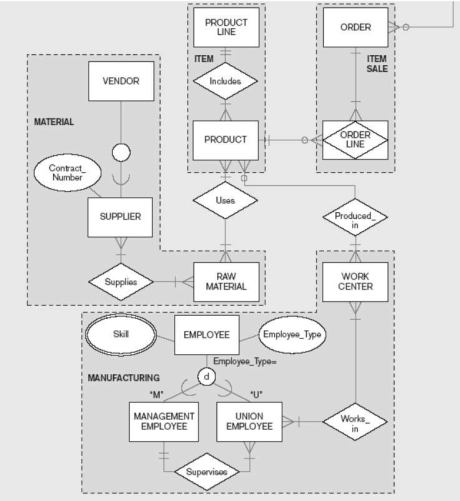
A) supertype/subtype hierarchy.
B) hierarchical data model.
C) entity cluster.
D) none of the above.

A) supertype/subtype hierarchy.
B) hierarchical data model.
C) entity cluster.
D) none of the above.

Unlock Deck
Unlock for access to all 74 flashcards in this deck.
Unlock Deck
k this deck
38
In packaged data models,all subtype/supertype relationships follow the ________ and ________ rules
A) partial specialization and disjoint
B) total specialization and disjoint
C) total specialization and overlap
D) partial specialization and overlap
A) partial specialization and disjoint
B) total specialization and disjoint
C) total specialization and overlap
D) partial specialization and overlap

Unlock Deck
Unlock for access to all 74 flashcards in this deck.
Unlock Deck
k this deck
39
Which of the following is NOT true of packaged data models?
A) Relationships are connected to the highest-level entity type in an order that makes sense.
B) All subtype/supertype relationships follow the total specialization and disjoint rules.
C) No entities on the many side of a relationship can be weak.
D) Both B and C.
A) Relationships are connected to the highest-level entity type in an order that makes sense.
B) All subtype/supertype relationships follow the total specialization and disjoint rules.
C) No entities on the many side of a relationship can be weak.
D) Both B and C.

Unlock Deck
Unlock for access to all 74 flashcards in this deck.
Unlock Deck
k this deck
40
A completeness constraint may specify that each entity of the supertype must be a member of some subtype in the relationship.

Unlock Deck
Unlock for access to all 74 flashcards in this deck.
Unlock Deck
k this deck
41
Subtypes at the lowest level of a hierarchy do not inherit attributes from their ancestors.

Unlock Deck
Unlock for access to all 74 flashcards in this deck.
Unlock Deck
k this deck
42
A subgrouping of the entities in an entity type that shares common attributes or relationships is called a(n)________.

Unlock Deck
Unlock for access to all 74 flashcards in this deck.
Unlock Deck
k this deck
43
In a supertype/subtype hierarchy,attributes are assigned at the highest logical level that is possible in the hierarchy.

Unlock Deck
Unlock for access to all 74 flashcards in this deck.
Unlock Deck
k this deck
44
The ________ specifies that each entity instance of the supertype must be a member of some subtype in the relationship.

Unlock Deck
Unlock for access to all 74 flashcards in this deck.
Unlock Deck
k this deck
45
Packaged data models are meant to be customized.

Unlock Deck
Unlock for access to all 74 flashcards in this deck.
Unlock Deck
k this deck
46
A ________ is a constraint that addresses the question of whether an instance of a supertype may simultaneously be a member of two or more subtypes.

Unlock Deck
Unlock for access to all 74 flashcards in this deck.
Unlock Deck
k this deck
47
Data models of an existing database are harder for data modelers to read.

Unlock Deck
Unlock for access to all 74 flashcards in this deck.
Unlock Deck
k this deck
48
An entity cluster should focus on some area of interest to some community of users,developers or managers.

Unlock Deck
Unlock for access to all 74 flashcards in this deck.
Unlock Deck
k this deck
49
Packaged data models can be developed using proven components.

Unlock Deck
Unlock for access to all 74 flashcards in this deck.
Unlock Deck
k this deck
50
A universal data model is a generic or template data model that can be reused as a starting point for a data modeling project.

Unlock Deck
Unlock for access to all 74 flashcards in this deck.
Unlock Deck
k this deck
51
A ________ constraint is a type of constraint that addresses whether an instance of a supertype must also be a member of at least one subtype.

Unlock Deck
Unlock for access to all 74 flashcards in this deck.
Unlock Deck
k this deck
52
Packaged data models cause projects to take more time to build.

Unlock Deck
Unlock for access to all 74 flashcards in this deck.
Unlock Deck
k this deck
53
Attribute inheritance is a property of subtype entities where they inherit ________ of all attributes of the supertype.

Unlock Deck
Unlock for access to all 74 flashcards in this deck.
Unlock Deck
k this deck
54
Entity clustering is a methodology for grouping one or more entity types and associated relationships into a single abstract entity type.

Unlock Deck
Unlock for access to all 74 flashcards in this deck.
Unlock Deck
k this deck
55
You should consider using supertype/subtypes when there are ________ that apply to some (but not all)instances of an entity type.

Unlock Deck
Unlock for access to all 74 flashcards in this deck.
Unlock Deck
k this deck
56
Packaged data models use an entity type to store union data.

Unlock Deck
Unlock for access to all 74 flashcards in this deck.
Unlock Deck
k this deck
57
Creating a data model from a packaged data model requires much more skill than creating one from scratch.

Unlock Deck
Unlock for access to all 74 flashcards in this deck.
Unlock Deck
k this deck
58
Packaged data models are as flexible as possible because all supertype/subtype relationships allow the total specialization and overlap rules.

Unlock Deck
Unlock for access to all 74 flashcards in this deck.
Unlock Deck
k this deck
59
The process of defining one or more subtypes of the supertype and forming supertype/subtype relationships is called ________.

Unlock Deck
Unlock for access to all 74 flashcards in this deck.
Unlock Deck
k this deck
60
An entity cluster can have a relationship with another entity cluster much the same way that an entity can have a relationship with another entity.

Unlock Deck
Unlock for access to all 74 flashcards in this deck.
Unlock Deck
k this deck
61
How is the data modeling process different when starting with a purchased solution?

Unlock Deck
Unlock for access to all 74 flashcards in this deck.
Unlock Deck
k this deck
62
The ________ specifies that an entity instance can simultaneously be a member of two or more subtypes.

Unlock Deck
Unlock for access to all 74 flashcards in this deck.
Unlock Deck
k this deck
63
Discuss when you would use total specialization and when you would use partial specialization.

Unlock Deck
Unlock for access to all 74 flashcards in this deck.
Unlock Deck
k this deck
64
A packaged data model can either be ________ or ________.

Unlock Deck
Unlock for access to all 74 flashcards in this deck.
Unlock Deck
k this deck
65
Contrast the overlap rule to the disjoint rule.

Unlock Deck
Unlock for access to all 74 flashcards in this deck.
Unlock Deck
k this deck
66
A(n)________ is a set of one or more entity types and associated relationships grouped into a single abstract entity type.

Unlock Deck
Unlock for access to all 74 flashcards in this deck.
Unlock Deck
k this deck
67
Explain why the E-R model needed to be expanded into the enhanced E-R model.

Unlock Deck
Unlock for access to all 74 flashcards in this deck.
Unlock Deck
k this deck
68
A supertype/subtype hierarchy is an arrangement of supertypes and subtypes where each ________ has only one ________.

Unlock Deck
Unlock for access to all 74 flashcards in this deck.
Unlock Deck
k this deck
69
An attribute of the supertype whose values determine the target subtype(s)is called a(n)________.

Unlock Deck
Unlock for access to all 74 flashcards in this deck.
Unlock Deck
k this deck
70
Explain the terms subtype and supertype.Discuss the differences between them.

Unlock Deck
Unlock for access to all 74 flashcards in this deck.
Unlock Deck
k this deck
71
Why are packaged data models gaining popularity?

Unlock Deck
Unlock for access to all 74 flashcards in this deck.
Unlock Deck
k this deck
72
Explain what entity clustering is.

Unlock Deck
Unlock for access to all 74 flashcards in this deck.
Unlock Deck
k this deck
73
Describe how subtype discriminators are used when we have overlapping subtypes.

Unlock Deck
Unlock for access to all 74 flashcards in this deck.
Unlock Deck
k this deck
74
Compare and contrast generalization and specialization.

Unlock Deck
Unlock for access to all 74 flashcards in this deck.
Unlock Deck
k this deck



